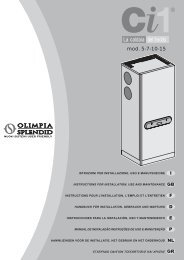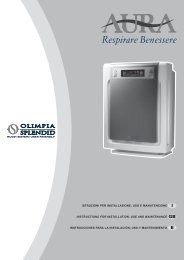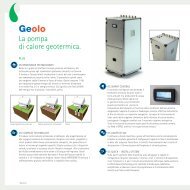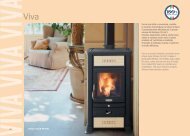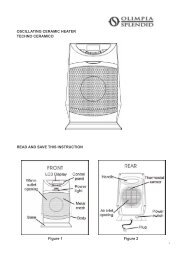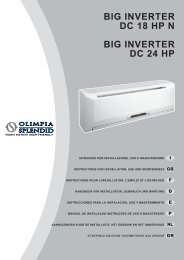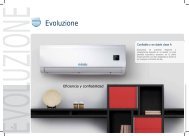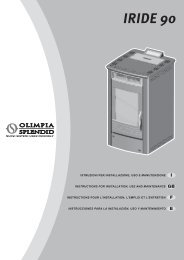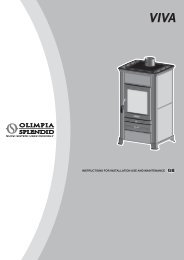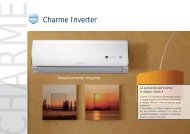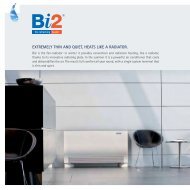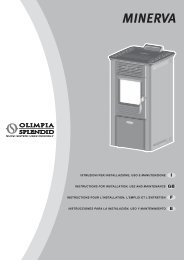manuale unico easy K180002300E.pmd - Olimpia Splendid
manuale unico easy K180002300E.pmd - Olimpia Splendid
manuale unico easy K180002300E.pmd - Olimpia Splendid
Create successful ePaper yourself
Turn your PDF publications into a flip-book with our unique Google optimized e-Paper software.
12<br />
I GB F D<br />
Per eseguire la foratura procedere<br />
come segue:<br />
Collocare la dima di foratura<br />
indotazione contro la parete rispettando<br />
le distanze minime: dal soffitto,<br />
dal pavimento e dalle pareti laterali<br />
indicate sulla dima stessa che<br />
può essere tenuta nella corretta posizione<br />
con del nastro adesivo.<br />
Tramite un piccolo trapano od un<br />
punteruolo tracciate con estrema cura<br />
il centro dei vari fori da praticare<br />
prima della loro realizzazione.<br />
Praticare, tramite una punta<br />
carotatrice di diametro minimo pari a<br />
162 mm i due fori per l’entrata e l’uscita<br />
dell’aria.<br />
La lunghezza massima consentita<br />
per i tubi è di 1 m, i tubi devono essere<br />
internamente lisci, di diametro pari a<br />
160 mm e non possono essere eseguite<br />
curve.<br />
E’ necessario utilizzare le griglie fornite<br />
in dotazione, oppure delle griglie<br />
che mantengano le medesime caratteristiche.<br />
To drill the holes, proceed as follows:<br />
Fasten the drilling template to the<br />
wall leaving the necessary space<br />
from the ceiling, floor and side walls<br />
as shown on the template. Use<br />
adhesive tape to fasten it in place.<br />
Use a small drill or punch to mark,<br />
with extreme care, the exact centre<br />
of each of the holes to be drilled.<br />
Using a core boring head measuring<br />
at least 162 mm to drill the two holes<br />
for entry and exit of the air.<br />
The maximum length allowed for pipes<br />
is 1 m. The pipes must be smooth on<br />
the inside, and with a diameter of 160<br />
mm. Pipes cannot be curved or bent.<br />
It is necessary to use the grilles<br />
provided, or grilles which keep the<br />
same features.<br />
Pour exécuter le perçage, procéder de<br />
la façon suivante:<br />
Placez le gabarit du perçage fourni contre<br />
le mur en respectant les distances<br />
minimums: par rapport au plafond, au<br />
sol et aux murs latéraux, indiqués sur<br />
ce gabarit. Celui-ci peut être maintenu<br />
dans la bonne position avec du ruban<br />
adhésif.<br />
A l'aide d'une petite perceuse ou d'un<br />
pointeur, tracez avec grand soin les<br />
centres des différents trous à effectuer<br />
avant leur réalisation.<br />
Effectuez avec un foret scie-trépan d'un<br />
diamètre minimum égal à 162 mm, les<br />
deux trous pour l'entrée et la sortie de<br />
l'air.<br />
La longueur maximale admise pour<br />
les tuyaux est de 1 m, les tuyaux<br />
doivent être lisses à l'intérieur, d'un<br />
diamètre égal à 160 mm et aucun<br />
coude ne peut être réalisé.<br />
Il faut utiliser les grilles fournies avec<br />
la machine, ou bien des grilles qui<br />
possèdent les mêmes<br />
caractéristiques.<br />
Für die Durchführung der Bohrungen ist<br />
wie folgt vorzugehen:<br />
Die mitgelieferte Bohrschablone an der<br />
Wand positionieren, wobei die auf der<br />
Schablone angegebenen<br />
Mindestabstände zur Decke, zum<br />
Fußboden und zu den seitlichen Wänden<br />
zu berücksichtigen sind. Die<br />
Bohrschablone kann durch Anbringen<br />
von Klebeband gegen ein Verrutschen<br />
geschützt werden. Mit einem kleinen<br />
Bohrer oder einem Treiber die Mitte der<br />
zu bohrenden Löcher sorgfältig anreißen.<br />
Mit einem Bohrkopf AD 162 mm, die<br />
zwei Löcher für den Luftein- und -austritt<br />
bohren.<br />
Die maximal zulässige Länge der<br />
Rohrleitungen beträgt 1m; die<br />
Rohrleitungen müssen innen glatt<br />
sein, einen Durchmesser von 160<br />
mm aufweisen und müssen ohne<br />
Kurven verlegt werden.<br />
Es müssen die mitgelieferten Gitter<br />
oder andere Gitter die dieselben<br />
Eigenschaften gewährleisten,<br />
verwendet werden.<br />
Avvertenze: Questi fori devono<br />
essere eseguiti con una leggera<br />
inclinazione verso l’esterno per<br />
impedire eventuali rientri di acqua dai<br />
condotti.<br />
Note: The holes should have a slight<br />
outward inclination to prevent any<br />
backflow of water from the pipes .<br />
Avertissement: Ces trous doivent être<br />
exécutés avec une légère inclinaison<br />
vers l'extérieur pour empêcher<br />
d'éventuelles rentrées d'eau par les<br />
conduits.<br />
Hinweis: Diese Bohrungen sind mit einer<br />
leichten Neigung zur Außenseite des<br />
Gebäudes hin durchzuführen, damit keine<br />
Feuchtigkeit (Regen) von außen eintreten<br />
kann.<br />
La maggior parte del materiale<br />
asportato viene espulso verso<br />
l’esterno, pertanto occorre cautelarsi<br />
che cadendo non colpisca<br />
persone e oggetti sottostanti.<br />
Per evitare il più possibile la rottura<br />
dell’intonaco esterno occorre<br />
procedere con molta cautela<br />
all’esecuzione della parte finale del<br />
foro allentando un po’ la pressione<br />
esercitata sulla carotatrice.<br />
Most of the removed material is<br />
expelled outwards, therefore make<br />
sure that it does not hit any person<br />
or object when it falls out.<br />
In order to avoid as much as possible<br />
outer plaster breaking, it is necessary<br />
to proceed carefully with the last part<br />
of hole execution, decreasing<br />
pressure on core borers.<br />
La plus grande partie de la matière<br />
enlevée est expulsée vers l’extérieur; il<br />
faut donc veiller à ce qu’en tombant,<br />
elle n’aille pas heurter les personnes ou<br />
les objets se trouvant dessous.<br />
Pour éviter le plus possible la rupture de<br />
l'enduit extérieur, il faut procéder avec<br />
beaucoup de soin pour l'exécution de la<br />
partie finale du trou en diminuant un peu<br />
la pression exercée sur la perceuse à<br />
scie-trépan.<br />
Das meiste abgetragene Material wird<br />
nach außen hin ausgestoßen, es ist<br />
daher dafür zu sorgen, dass es beim<br />
Herunterfallen keine Personen oder<br />
Gegenstände trifft.<br />
Damit der Außenputz möglichst nicht<br />
beschädigt wird, ist der letzte Bereich<br />
des Lochs mit großer Sorgfalt<br />
durchzuführen, indem man den auf den<br />
Betonbohrer auszuübenden Druck<br />
verringert.<br />
Eseguire i due fori di diametro 6 mm<br />
relativi all’ancoraggio della staffa di<br />
fissaggio a parete utilizzando la dima<br />
di foratura.<br />
Make two 6 mm diameter holes in<br />
correspondence with the anchor<br />
points of the wall-fixing bracket using<br />
the template provided.<br />
Percer deux orifices de 6 mm de<br />
diamètre destinés à recevoir le<br />
support de fixation murale, en utilisant<br />
le gabarit fourni.<br />
Führen Sie die beiden 6-mm-<br />
Bohrungen für die Verankerung des<br />
Wandbefestigungsbügels unter<br />
Verwendung der Bohrschablone aus.<br />
1<br />
693<br />
= =<br />
360<br />
= =<br />
ø 6 mm<br />
PER STAFFA<br />
POUR LA BRIDE<br />
FOR BRACKET<br />
FUR DEN BUGEL<br />
POR ESTRIBO<br />
VOOR BEUGEL<br />
64<br />
666<br />
160<br />
293<br />
DIMA DI FORATURA - GABARIT DE PERCAGE<br />
DRILLING TEMPLATE - BOHRENSCHABLONE<br />
PLANTILLA DE TALADRADO - BOORMAL<br />
314MIN - 322 MAX<br />
22



